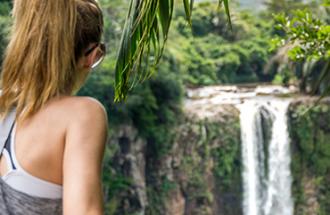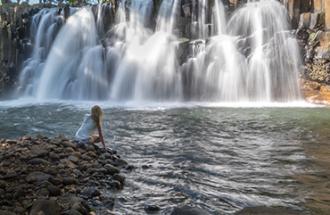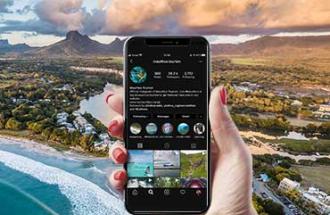Port Louis, the capital city of Mauritius
Port Louis, the capital city of Mauritius
Port Louis, the capital city of Mauritius, is a vibrant town. Located in the north-west of the country, Port-Louis will touch you for sure. Founded by French Governor Bertrand-François Mahé de Labourdonnais in 1735, the city is the economic hub of the island and is very lively during the day, teeming with life. Visit the colourful market, stroll through the streets, visit museums and other historical and cultural sites, taste the flavours of Mauritian street-food and meet the population … A tour in the capital is a must during your stay in Mauritius, let yourself be impregnated by the local life, the history and the culture of Mauritius. Port-Louis is a cultural melting pot, a city where traditions and the modern go alongside.
An entire day would probably not be enough to see all places of interest in Port Louis. You can start your journey at the Caudan Waterfront, the shopping centre located on the harbour front, and leave your car there before beginning your tour of the capital.
You will be struck by the beautiful avenue bordered with giant palm trees, facing the harbour. It is the Place d'Armes, also called Place Sookdeo Bissoondoyal, which leads to the Government House, built in the early 18th century during the French era, now housing the parliament sessions.
A visit to the Port-Louis market is a must. Embark on a journey for your senses, be amused by the very inspired glibness of vendors, follow the aromatic smells of fruit and vegetables, and taste those exotic flavours that are unknown to you. No doubt you will come out with a smile on your face. The craft and souvenir market next to the vegetable zone is also to be seen, though bargaining is recommended in this part of the bazaar.
To get a real feel of Port-Louis, you must take the time to walk along its streets. Heading north on the Royal Road, you will reach Chinatown, the old Chinese locality that conceals a lot of cultural and culinary treasures. You will find all kinds of shops, from traditional medicine to souvenir shops and grocery stores where you will find ingredients only available in the in the area. If you pay attention, you could even notice a small pagoda nestled between shops and restaurants… The Chinese community in Mauritius comes mainly from Guangzhou. At the end of the 18th century, during colonial times, the Chinese travelled to Mauritius to operate shops and craft workshops on the island. Since then, a community has settled here.
At the entrance of Chinatown sits the Jummah Mosque, an outstanding building constructed at the end of the 19th century for Mauritians of Muslim faith, and which is still open for daily prayers.
The Mauritian street food is also very famous and Port-Louis is the ideal place to taste all the flavours that make up the Mauritian culinary culture. The choice is yours: dholl puris and faratas – large pancakes made with flour and split peas served with various spicy sauces and currys, chilli cakes - small crispy chickpeas cakes with chilli, Chinese dumplings - tasty meat and vegetable balls, Chinese-style stir-fried noodles, and the famous bryani, a rice dish prepared with vegetables and meat with special spices, a delight!
One of the jewels of the capital is its theatre, currently under renovation, which dates back to the 19th century and has seen many theatrical groups performing on stage during its glorious days. It regularly hosted finest operas and operettas in vogue in Europe, and the theatre of Port Louis, one of the oldest in the region, was known for its exceptional acoustics.
Would you like to take a break to cool down before continuing your expedition? The Jardin de la Compagnie, few minutes away from the Government House, will offer you a nice breath of air in the shade of the centenary trees and big Banyan trees. You will come across statues and busts of some men who marked the history of Mauritius such as Léoville L'Homme and Rémy Ollier.
If you want to gain some height, the Citadelle, also known as Fort Adelaide, is the place to go. An old stone fortress built on the hill by the British to defend the capital, the Citadellle now houses shops and serves as a venue for shows and other cultural events. You will have a stunning view of Port Louis and the harbour!
At the foot of the hill sits the Champ de Mars dating back to the early 19th century, one of the oldest horse racing tracks in the southern hemisphere. The Champ de Mars is part of the Mauritian heritage. If you are in Mauritius between May and early December, you should attend a horse racing day and discover one of the many facets of Mauritian folklore.
The monument of Marie Reine de la Paix, further south of Port-Louis, will give you another point of view of the capital from above. It was raised in honour of the Holy virgin by the Christians. From this very pleasant place with its nicely maintained flowerbeds, you will have a spectacular view of the capital.
Port Louis and History
The history of a country can also be revealed through its museums, and Port Louis houses several of them, all different and yet complementary. Next to the Jardin de la Compagnie, the Natural History Museum awaits you. Discover the history and wildlife of Mauritius, and of course, the famous extinct Dodo reconstituted as well as the various bones found in Mauritius and throughout the world.
A few minutes away, there is the Photography Museum tracing the history of photography in Mauritius. The numerous artefacts and clichés collected over time are a real Aladdin’s cave for amateurs and the curious as well. The museum is located at Vieux Conseil Street, one of the few streets that are still cobbled from the French colonial era.
The Bank of Mauritius features an unexpected collection of coins that have gone throughout history in its museum, some were used in Mauritius and others just appeared out of nowhere. The museum is open on weekdays and guided tours can be arranged for groups.
The other museums of the capital are located on the harbour front, starting with the Beekrumsing Ramlallah Interpretation Centre, next to the Aapravasi Ghat, which traces the history of Indian indentured labourers who arrived in Mauritius in the 19th century, after the abolition of slavery. This centre encloses documentation and artefacts, and also features a ten-minute film on the testimonials of the workers’ descendants. You can visit the Aapravasi Ghat, next to the centre, the place where the Indian labourers landed and which forms part of the UNESCO World Heritage Site.
On your way to the Caudan Waterfront, you will pass an imposing brick building, the Granary, built under the British government nearly 100 years ago. It has not been used much for its primary function and now serves as a parking lot for employees of the city. There is, however, an interesting anecdote that relates that the frontage on the sea side had been camouflaged in order to deceive the enemy during the Second World War, a granary being a strategic target in times of war; a French naval painter, Maurice Ménardeau, had created a fresco in trompe-l'oeil, and those arriving by the sea could only perceive a small village and houses.
In front of the Granary stands the Postal Museum, a beautiful preserved stone building that will enchant philatelists and lovers of postal history.
The Blue Penny Museum act the Caudan Waterfront is known for the extremely rare Blue Penny stamps that it houses. You will learn the history of these stamps that have travelled the world, but also the history and culture of Mauritius.
The Rajiv Gandhi Science Centre in Bell Village, a southern suburb of Port-Louis, will be perfect for the science enthusiasts. It is not a museum, but a venture into the world of science will definitely amuse children who will have the opportunity to take part in some interactive activities.

Shopping
Port-Louis offers a wide range of shopping options. In the city centre, all you need to do is walk the streets to find the articles you are looking for. There are all kinds of stores there; in some streets, the shops are grouped by categories, such as the Corderie Street, intended for fabric stores and Royal Road for hardware stores. You will find everything, just take your time and venture into the shop mazes; do engage in conversation with the traders, they will be delighted to talk about Mauritian culture.
The Caudan Waterfront is also a great place for shopping and wandering around. Located on the harbour front, separated from the city centre by the motorway, Caudan Waterfront offers an all-in-one formula with its various brands, restaurants, cinemas and museum. You can simply take a stroll there and enjoy the view of the harbour and the mountains of Port Louis. The place is also very pleasant in the evening, offering a different atmosphere than during the day. The newly built polyvalent cultural centre, the Caudan Arts Centre, frequently hosts shows, exhibitions and other artistic events.
Next to the Caudan Waterfront, the Port Louis Waterfront and its Astrolabe will offer you an equally interesting shopping and restaurant experience, facing the sea.
Why not hop on the Metro Express, the new tramway from Caudan and head towards the urban centre of the island? For now, the line stops at Rose-Hill, but it will soon connect the towns of Quatre-Bornes and Curepipe.




